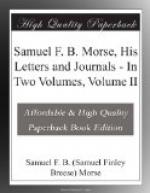“Now, my dear sir, with this frank statement of my views on this point, I accept your invitation, and will go to see you at your house to talk with you upon this point and others, perhaps more agreeable, but if, after this expression of my inclinations, you will not deem me a welcome guest, telegraph me not to come—I will not take it unkindly.”
To this Morse replied on August 23: “Your most acceptable letter, with the tone and spirit of which I am most gratified, is just received, for which accept my thanks. I shall be most happy to see you and freely to communicate with you on the subject mentioned, and with the sincere desire of a satisfactory result.”
The visit was paid, but the details of the conversation have not been preserved. However, we find in Morse’s report, on page 10, the following: “In 1825, Mr. Sturgeon, of England, made the first electro-magnet in the horseshoe form by loosely winding a piece of iron wire with a spiral of copper wire. In the United States, as early as 1831, the experimental researches of Professor Joseph Henry were of great importance in advancing the science of electro-magnetism. He may be said to have carried the electro-magnet, in its lifting powers, to its greatest perfection. Reflecting upon the principle of Professor Schweigger’s galvanometer, he constructed magnets in which great power could be developed by a very small galvanic element. His published paper in 1831 shows that he experimented with wires of different lengths, and he noted the amount of magnetism which could be induced through them at various lengths by means of batteries composed of a single element, and also of many elements. He states that the magnetic action of ’a current from a trough composed of many pairs is at least not sensibly diminished by passing through a long wire,’ and he incidentally noted the bearing of this fact upon the project of an electro-magnetic telegraph [semaphore?].
“In more recent papers, first published in 1857, it appears that Professor Henry demonstrated before his pupils the practicability of ringing a bell, by means of electro-magnetism, at a distance.”
Whether Professor Blake was satisfied with this change from the original manuscript is not recorded. Morse evidently thought that he had made the amende honorable, but Henry, coldly proud man that he was, still held aloof from a reconciliation, for I have been informed that he even refused to be present at the memorial services held in Washington after the death of Morse.
In a letter of May 10, 1869, to Dr. Leonard Gale, some interesting facts concerning the reading by sound are given:—




